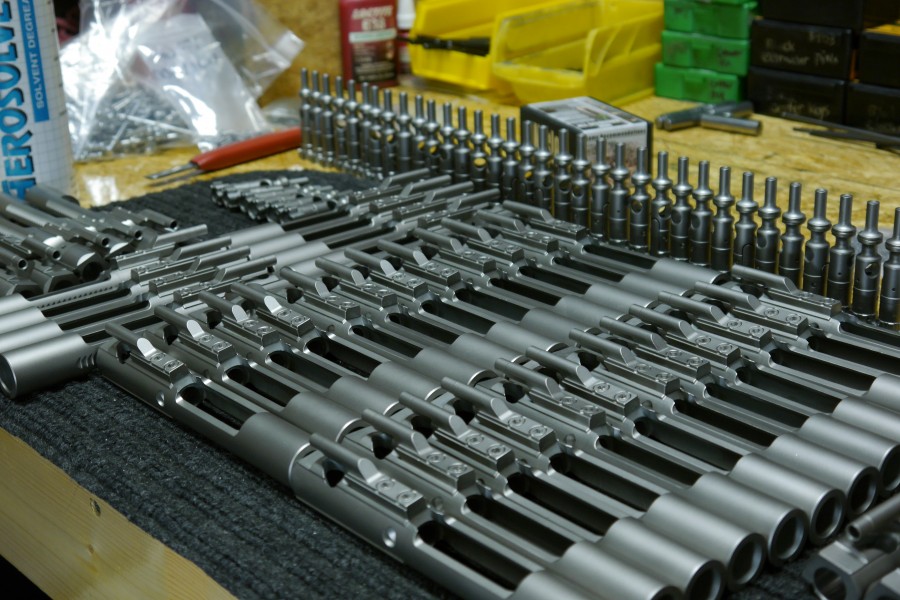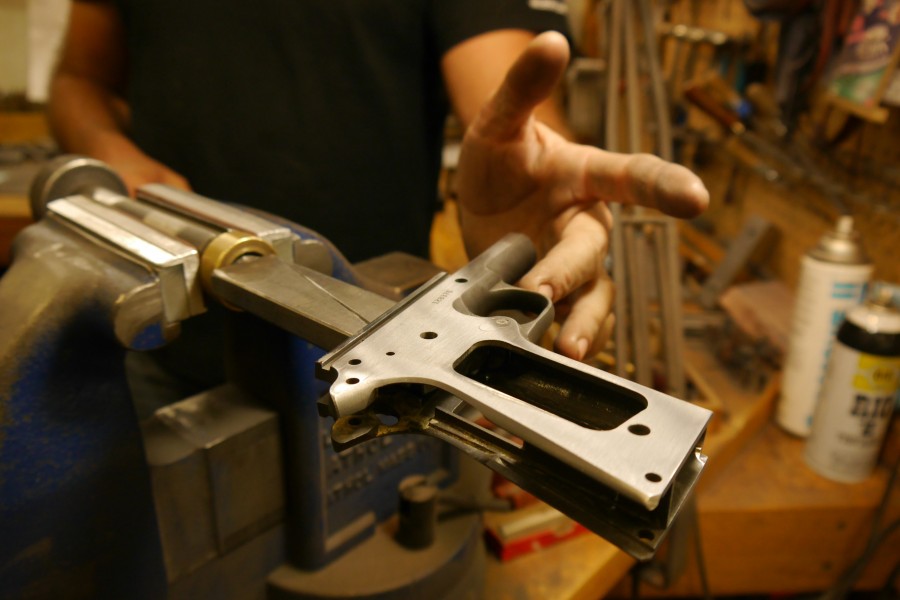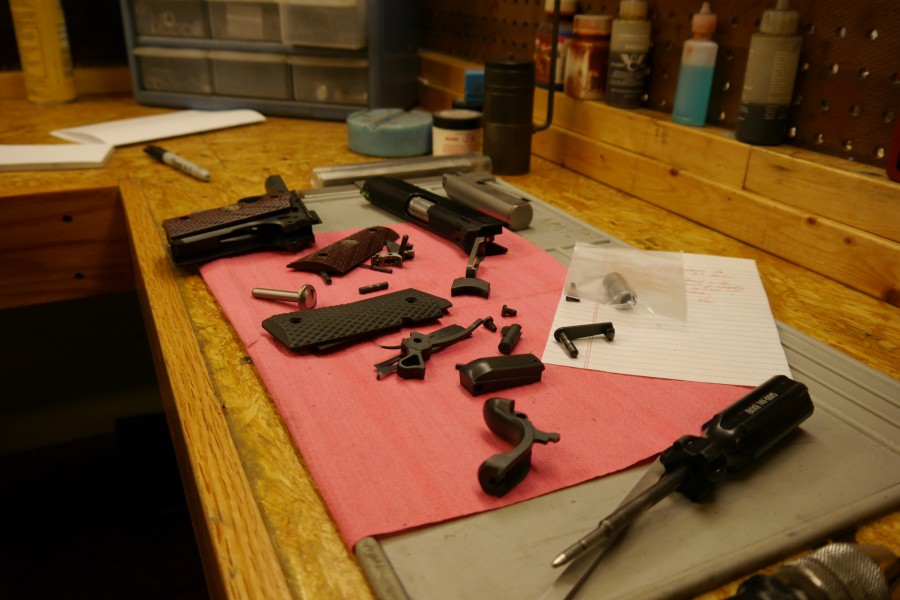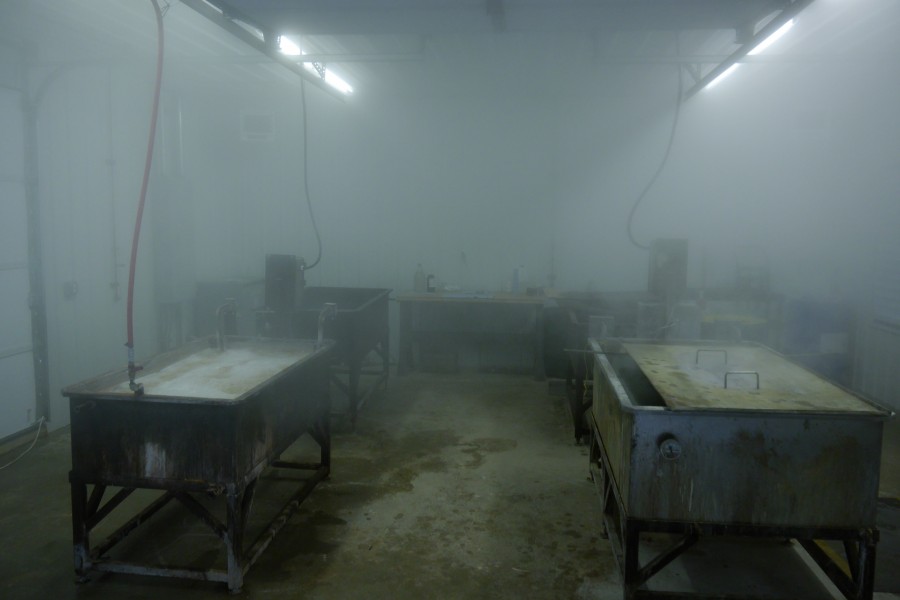There isn’t really much debate when it comes to the quality of Wilson Combat’s 1911 handguns. There are only a couple of true custom 1911 builders in the United States, and Wilson Combat is the benchmark against which the others are judged. While I own an example of their work, I’d never actually seen how their handguns are made. Last week I was invited down to their facility in Arkansas to check out their new digs, and watching the process from start to finish was pretty cool . . .
Wilson Combat is located in the middle of nowhere. They are the third largest employer in the county, right behind the local Wal-Mart and a meat processing plant — which says more about the sparse population of the area than the size of WC.
Until recently WC had been located in a tiny brick building off a dirt road, but with the increase in orders and staffing they’ve been able to move to a new, modern, and spacious multi-building facility up the road built specifically for Wilson Combat.
Walking in the front door, the first thing you see are the sales and support staff, and there certainly are a lot of them. The team answers emails and takes phone calls all day long, helping existing and prospective customers with everything from troubleshooting a feeding issue to figuring out which parts should go into their newest pride and joy. Some of the people may look a little young, but the team is anchored by a number of experts who spent their entire careers with Wilson Combat, usually in the machine shop, and have found a new home providing their decades of expertise to anyone in need.
According to the WC guys, there’s rarely an order that comes in where the buyer wants their handgun spec’ed out exactly like the models on the website. Usually the orders use those models as a starting point, then request a few extra details like a larger slide release or a different thumb safety setup. Once the order is finalized, they head out into the warehouse.

While Wilson Combat’s handguns are what WC is best known for, in their estimation they do about 50% of their sales in complete firearms and the other 50% in parts. Wilson Combat parts are available damn near everywhere, and while some of them are made in-house, others come from trusted suppliers elsewhere in the country. There are some shops, they say, where Wilson Combat is their only customer and has been for decades. Nevertheless, each part that comes in gets tested to ensure that it meets the specifications, and then is either packaged for retail sale or put on the shelves as stock for gun orders.
When an order comes in, this little station is where it starts to come together. A worker selects the required parts from inventory according to the order form, then places it all in a bin for pickup. Every so often a couple workers from the firearms side of the factory come in to collect those tubs and mate them up with the appropriate slides and frames that will constitute the bulk of the order.
Over in the CNC building, brand new CNC machines are whirring away making the slides and frames for each order. In addition to pistol parts, these machines also turn out the receivers for their AR-15 and AR-10 line of rifles, and there’s quite a few of them working on guns in all stages of completion.
According to the ATF, as soon as the 1911 frame has the rails and pin holes milled into it the part officially becomes a firearm. With WC, they’ve configured their CNC machine to serialize each frame in the same program that cuts those last few operations. The machine is programmed to mill serial numbers sequentially, and only mill one serial number one time. If that frame later has a problem (like, gets run over by a truck before completion) then that serial number will be lost forever and never exist as a finished firearm.
The slide and frame are mated at this point in the process and remain together until delivery. The two parts are hand lapped together to provide a smooth feeling when cycling the action, yet will be almost perfectly aligned with each other. It’s one more detail that puts WC’s handguns above the mass produced competition.
Handgun barrels are produced elsewhere. In fact, Wilson Combat doesn’t really “do” barrels. Like many of their parts, they rely on experts in other places to make that magic happen. However, for their AR-15 and AR-10 pattern rifles, they are getting into the barrel business big time. They use barrel blanks from a supplier, but the bores are drilled in-house, rifled on a brand new rifling machine (that only started working the day before I arrived), and each individual groove is lapped to a mirror finish. After all that stress, the barrels are then heat treated and made ready for installation.
A quick aside; Wilson Combat was one of the first custom shops in the AR-15 game. Since the late 1990’s, WC has been cranking out their very own custom rifles. But with the rise of the AR-15 rifle in popularity. Wilson’s monopoly in that space has been challenged and they have become more noted for their precision handguns instead.
One way Wilson is getting back on top in the long gun market is by focusing on the wildcat and oddball calibers. According to WC’s guys, the market for NATO calibers is pretty much flat, but as soon as you offer something in .458 SOCOM or .260 Remington people will start spending the big bucks again for top quality guns.
Hence the reason for rifles such as this .458 SOCOM custom build.
The rifles are manufactured with the same care and precision as Wilson’s handguns. The lower receivers are milled from a single solid block of aliminum, and instead of broaching the magazine well, the lowers have those EDM machined out. This keeps the part from being stressed, all while making the mag well as precisely as possible for accurate and reliable feeding.
The rifles are assembled in a building just off the CNC machine shop. There’s a vault located in that building where the lower receivers are stored until an order comes in, at which time they are brought out to a workbench and assembled.
Every rifle ships with the same collapsible lightweight stock, and for good reason: they are easy to swap, and allow the customer to choose the stock that’s right for them. Instead of needing to stock a Noah’s Ark of stocks, this approach lets them maintain consistency in the product line while still allowing the customer to customize their specific gun. They do, however, have plans to branch out to include some of the more popular stocks in the future.

The densest building in the production area is the handgun assembly shop. Here, master craftsmen assemble each handgun one-by-one, fitting each individual part and ensuring that it meets the high expectations of the customers. The work is done mainly using hand tools, with very few (if any) electric or pneumatic tools. I don’t think I’ve ever seen more varieties of files in my life.
One of the workers explained that there was just a different “feel” to the work that is done by hand as opposed to a computer. On this frame, he was adding some serrations to the gripping surfaces by hand, and while he had a machine that would do the same job quicker and much more precisely, he explained how sometimes it was better to fit the serrations to the individual handgun rather than be concerned about having each line exactly parallel and consistent.
That frame might seem a little different, and that’s because it is. Wilson Combat makes their own handguns, but like most custom shops they got their start accurizing and “fixing” the work of other companies. In this case, the Springfield on his bench was getting a makeover at the request of a customer. He also works on Colt 1911s, Remington 1911s and others.
Wilson Combat has spread out to include work on Beretta handguns as well recently with their line of 92FS parts, and even has their own custom Beretta 92 handguns now. When asked what might be next on the list for extensions into other brands and models, they reluctantly admitted that something striker fired was probably on the horizon — depending on how Bill Wilson feels.
Before we move on, here are some more pictures of new Wilson Combat guns in progress.
This gun is starting the fitting process at the very beginning stages of manufacturing.
This is a customer’s handgun that was sent in for a tune-up and have some new parts installed.
A gunsmith manually polishes the feed ramp for a 1911 barrel.
When new guns area all tricked out, the parts head off to the paint and surface treatment area. Most shops will have some areas to Cerakote their guns, but not many have on–site blueing and parkerizing facilities. With Wilson Combat, all of the parts (well, the non-stainless ones) are blued or parkerized before being coated with their own armor tough paint.
The final step in the process is test firing. Every single firearm is test fired at Wilson Combat’s private range, located on one end of the manufacturing facility.
What’s truly remarkable is how these guns are test fired. Instead of using a Ransom rest or other mechanical device, the handguns are shot by hand, using nothing but a couple leather sandbags for support. The handguns are all zeroed at 15 yards, which is perfect for most people — our own Robert Farago being the notable exception.
Robert actually sent his brand new Wilson Combat handgun back to the factory to have it re-zeroed… at 7 yards. Why? I have no idea. But that’s what he wanted. When I was at the factory, he hadn’t gotten his baby back yet and asked me to look in on it. So I did.
This is Robert’s gun, and that’s me with the shit-eating grin holding it. It was 100% finished, and just needed to be shipped back. I asked them to put it at the bottom of the pile and forget about it for a couple weeks, and they seemed happy to oblige.
Once the guns are ready to be shipped, they are moved to a vault near the front office. Every single firearm gets a padded soft carrying case, along with a magazine or two and some extra goodies. The guns ship out nearly as soon as they are finished, which is why there aren’t many piled up in this picture.
The one thing that wasn’t really discussed was the line of silencers that Wilson Combat is putting out. According to the WC guys they sell a number of them, but nowhere near the volume of a larger silencer shop. Their market is mainly people who already own a Wilson Combat rifle and want a silencer that matches the asthetics of their existing guns. The development process for these cans is mainly a trial and error system, and the reason for the low volume is that they are — like the guns they go on — custom one-off pieces. There really isn’t an established “line” of Wilson Combat silencers. Yet.
Visiting the Wilson Combat factory was a really cool experience. I own a Bill Wilson Carry of my own, and it goes with me everywhere I do. Seeing how its made from start to finish was amazing, and makes me appreciate the craftsmanship all the more.



























Sweet! Huge warehouse. Love the wide trigger guard and flared magwell on those AR lowers! …and you’re looking svelte these days, sir.
Wilson Combat? Striker Fired? I fully support this decision.
http://i3.kym-cdn.com/photos/images/newsfeed/000/264/241/9e9.gif
Larry Vickers had some recent videos posted at the factory. I would love to visit their factory. I have a weird desire for a Beretta after looking at the few samples I have seen online.
I was headed off to my friends lake house one day when my GPS sent me an unexpected way. I thought I had made a wrong turn and was about to turn around when there appeared before my eyes Wilson Combat, in what appeared to be a pretty new building.
Yes, it is out in the middle of nowhere but not far from a favorite vacation spot that is so gorgeous I won’t disclose the location. It’s top secret.
Good thing there’s nothing like Google Maps to give that secret away…
Bill Wilson thought the area was so pretty he moved to Texas.
And I think Texas is so purty, I’m moving to Arkansas.
…and who could blame you?
Until a year ago I had never bought a high end handgun. I carried the usual assortment of duty guns: SIG’s P 226’s & 220’s and competed with everything from S & W revolvers to highly modified Springfield Armory 1911’s and XD’s. I have also competed with various Kimbers, both stock and high-end. Last year I had the opportunity to acquire a $$$ firearm. Wilson, Brown, Nighthawk , even Cabot. I saw a Les Baer with the 1.5″ guarantee. I dry fired it and almost said yes, but my LGS had ordered 2. The one I tried had a test target of 1.5″ or so and a pretty good trigger. The Wilsons, etc, had better triggers and were prettier, but I kept coming back to that test target. Then I asked my buddy, the LGS manager what I should do. He then brought out a Les Baer that had a test target with one actual hole 0.625 c-to-c. I took it and have not looked back since. The bluing is sh*tty; bare metal shows in several places. It is not nearly as pretty as the Wilsons, but I have over 5,000 rds trouble free through her and it is rifle accurate. I have detail stripped her only once and was totally impressed by the precision of the parts and the overall quality.
Would I get a Wilson? Sure. All man made things have variation. If you happen across something whose deviations add up to something unique, grab on.
Journalism/editing note:
Once you do this – Wilson Combat (WC), once in the article you never have to spell out WC again for the remainder. Isn’t that great? Sorry, worked with a multi-lingual professional technical editor for years…….
Have to? What does have have to do with it? Has Nick no choice? No option or free will to refer to WC by its full name once yclept WC? I’m not sure he realized he was making such a commitment.
The commitment is definitely long term 😉
Wilson Combat P7!
Take my money pleaseeeeee!
Wilson has already done a striker fired gun. In the late 90s you could get a Kahr K9 done up by Wilson Combat.
Fedlaw – I’ve owned Wilsons, Nighthawks, Ed Brown’s and Les Baers. In the craziness of 2013 they all got sold for huge profits. Except for the Les Baer Premier II. All 3 of those other guns are much “nicer” guns. But they don’t shoot any better. Besides, who cares if you can find a tool mark on the inside of the magwell?
A few years ago I was in the market for a custom1911.
I was considering a Wilson, but by chance I inherited a stock stainless Springfield Arms 1911. I decided to send it off to Robar and have the Thunder Ranch build done on it. I haven’t looked back. It is the finest 1911 I have fired. This thing drives tacs. Out of a couple of thousand rounds only 1 FTF and that was due to crappy range reloads. I would like to pick up a Wilson in the future, but the Robar Hi-Power is calling out to me. Does Wilson do Browning’s? http://robarguns.com/custom-weapons/handguns/browning-hi-power/
I forgot about those Robar Hi Powers. I want one of those.
I did the same thing Wilson does. I got a very good slide/frame (in my case S&W stainless steel, melonited, hand-fit, a PC shop bit) and had Briley hand-fit a match barrel and bushing of their manufacture. Wilson sends out for their barrels and bushings, too. Nobody does a better job on those than Briley. The accuracy of the thing is wonderful, although I had to have my range manager friend use a Ransom Rest to find out. (I’m just not that good.) I saved at least $800 doing it my way, and got exactly the parts and finishes I wanted, without the goofy looking “rays of the rising sun” grip panels. (Tastes differ…) Mine has Crimson Trace Laser Grips instead. It’s a fighting gun, after all. Have to be able to make those awkward shots….
There is so much hokey crap in the 1911 marketing world it is astounding. But I respect marketing chutzpah. I noticed Wilson was selling a refinished and repainted 870 for $1,300. I called to ask if it had the all-metal police fire-control-group. “No.” Are interchangeable choke tubes included? “No.” The model was called the Border Patrol. Perfect. Our border patrol isn’t allowed to shoot anyone anyway. Who buys these things? Is there a Wilson Fanboi thing like the HK fanboi thing?
There’s a lot more to Wilson’s modification of the 870 than you mention. Reason I know is that TTAG wrote a v. good article on subject…after you wrote your comment, so you did not have opportunity to know that.
Here’s link,so you can read it.
https://www.thetruthaboutguns.com/2016/04/jon-wayne-taylor/gun-review-wilson-combat-border-patrol-shotgun/
Comment I just posted a minute ago was directed to “ropingdown”, not at the author!
It’s nice to see how in these years your factory has got bigger, I’m one of your most faithful customers, and I’m really pleased that things seem to go ok with you. Congratulations again.
I have a BWC that has been my EDC for quite a while. Is easily my fav handgun I’ve ever owned, lately I’ve been thinking about going back to WC for an AR
Comments are closed.